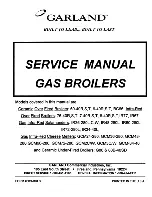
13
Cleaning
Keeping a daily watch on the burning process
in the boiler and making necessary adjust-
ments make the cleaning process a problem
free and infrequent job. Good burning forms a
thin grey or coffee colored layer on the firing
surfaces of the boiler, which falls off itself.
Poor burning forms a dirty layer of soot, as-
hes, and tar on the firing surfaces and inside
the flue. This prevents thermal energy from
transferring to water thus increasing the flue
gas temperature and lowering the efficiency.
Cleaning should be performed as follows:
1.
Remove ashes from the fire bar and fur-
nace.
2.
Remove turbulators from the convection
ducts.
3.
Clean the convection ducts with a metal
brush.
4.
Clean the firing surfaces with a metal
brush.
To control contamination of the boiler check
the flue gas temperature. When the tempera-
ture rises 30 …50 ºC higher as compared with
the clean boiler, it means that the boiler needs
to be cleaned.
Note that tar can stick to the walls of the stor-
age furnace, which is normal so you do not
have to clean the walls.
When cleaning the stack check also the smoke
exhauster blades.
Troubleshooting
The boiler water temperature does not rise to the desired level
•
Ensure that the primary and secondary air
ratio and access are correct.
•
Ensure that the firewood is dry.
•
If there is a cooling coil in the boiler
•
Make sure that the mixing valve functions
properly.
The boiler boils and sputters
•
Ensure that there is enough water in the
system and the pressure is between 1 and
1.5 bar. If there is no water in the system
stop the heating process immediately by
extinguishing fire. Do not add water to the
boiler but let it cool down by driving cold
air through it. When the boiler is cool, you
can fill the system with water and restart
heating.
•
Check that the pump and the mixing valve
are working and check the circulation
through the pump and piping. The air pre-
sent in the system can inhibit water circu-
lation.
•
Ensure that the furnace bottom bricks are
in place and in good condition.
The flue gas temperature is too high
•
Clean the boiler. Soot, ashes, and tar con-
taminate the firing surface and act as
thermal insulation.
•
The flue gas temperature should not ex-
ceed 350 ºC as the boiler can break down
and the flues cannot withstand high tem-
peratures. Ensure that the primary and se-
condary air ratio and volume are correct.
•
Ensure that turbulators are in place and in
good condition.
•
Ensure that the firing throat seal is in good
order.


































